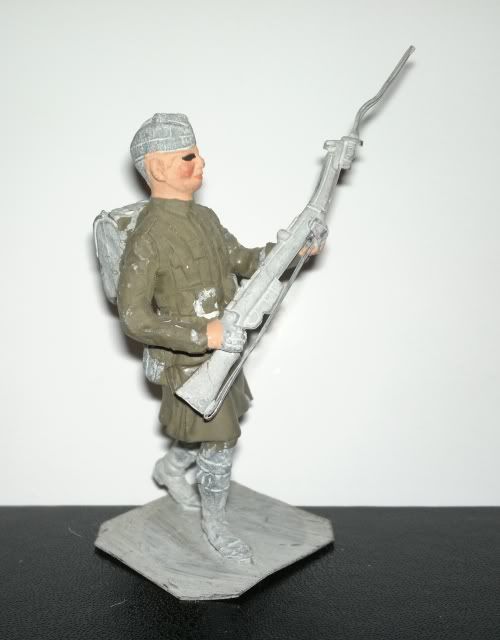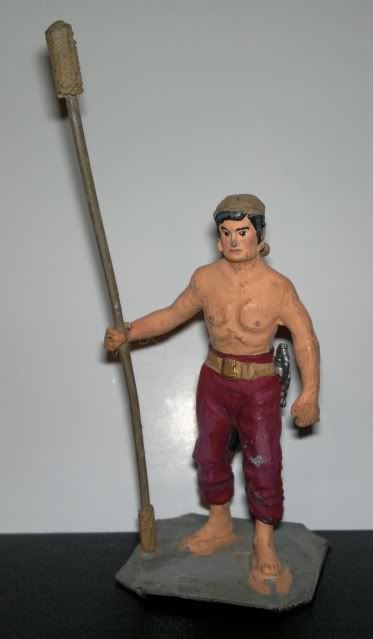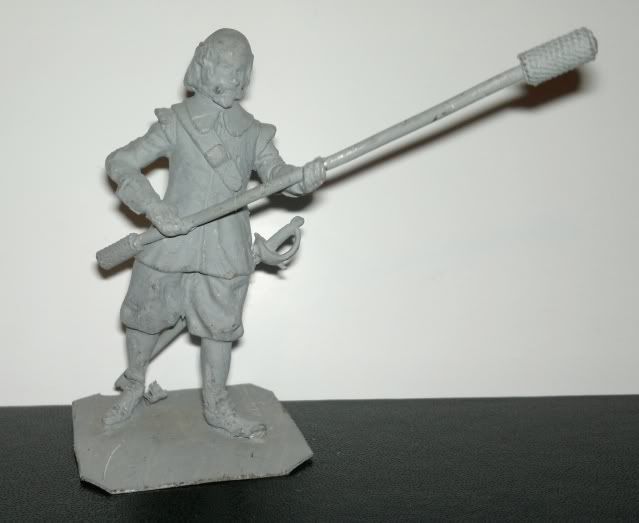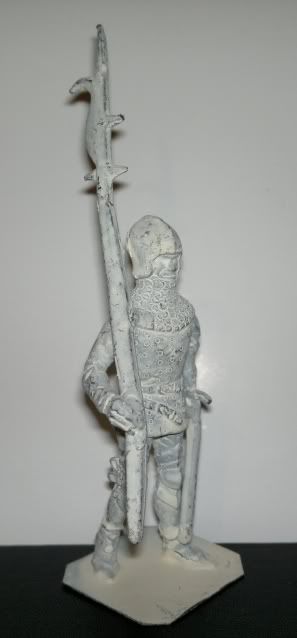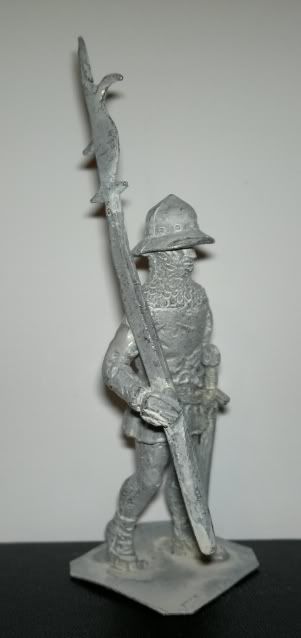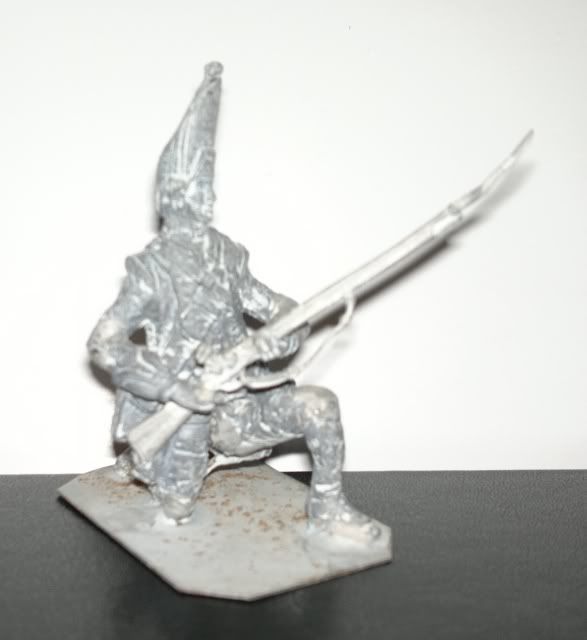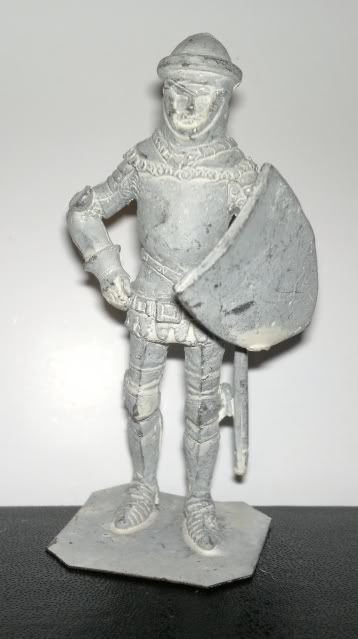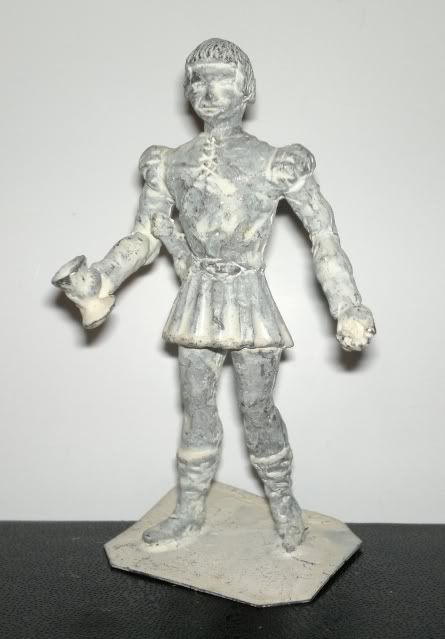Thursday 31 May 2012
dan dare by crescent
 The firm was founded by Henry Eagles and Arthur Schneider and was located at DeBeauvoir Crescent, Kingston Road London.
The firm was founded by Henry Eagles and Arthur Schneider and was located at DeBeauvoir Crescent, Kingston Road London.
When Henry Eagles died in 1942, his son Harry who was called "Harvey" entered the firm. Crescent restarted after World War II stamping their product DCMT for Die Cast Machine Tools. In 1949 the firm moved to Cwmcarn Wales with "Harvey" Eagles staying in London and setting up a firm by the name of Harvey. Harvey sold his name to the Lone Star Toyscompany.
Die Cast Machine Tools. In 1949 the firm moved to Cwmcarn Wales with "Harvey" Eagles staying in London and setting up a firm by the name of Harvey. Harvey sold his name to the Lone Star Toyscompany.
 Die Cast Machine Tools. In 1949 the firm moved to Cwmcarn Wales with "Harvey" Eagles staying in London and setting up a firm by the name of Harvey. Harvey sold his name to the Lone Star Toyscompany.
Die Cast Machine Tools. In 1949 the firm moved to Cwmcarn Wales with "Harvey" Eagles staying in London and setting up a firm by the name of Harvey. Harvey sold his name to the Lone Star Toyscompany.
Prior to the war, Crescent acquired moulds and stock from C.W. Baker who traded as Reka. Crescent manufactured a series of dioramas depicting various shops and a classroom from  1950s Britain. The company also manufactured Dan Dare sets of figures[ and Thunderbirds toys.
1950s Britain. The company also manufactured Dan Dare sets of figures[ and Thunderbirds toys.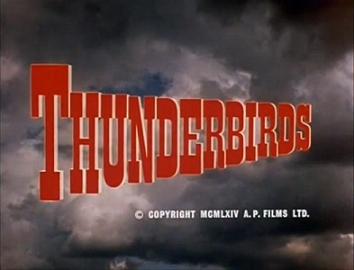 Dan Dare is a British science fiction comic hero, created by illustrator Frank Hampson who also wrote the first stories, that is, the Venus and Red Moon stories, and a complete storyline for Operation Saturn. Dare appeared in the Eagle comic story
Dan Dare is a British science fiction comic hero, created by illustrator Frank Hampson who also wrote the first stories, that is, the Venus and Red Moon stories, and a complete storyline for Operation Saturn. Dare appeared in the Eagle comic story Dan Dare, Pilot of the Future in 1950, dramatised seven times a week on Radio Luxembourg.
Dan Dare, Pilot of the Future in 1950, dramatised seven times a week on Radio Luxembourg.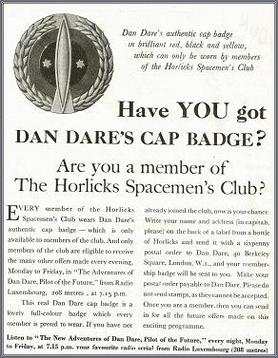
 1950s Britain. The company also manufactured Dan Dare sets of figures[ and Thunderbirds toys.
1950s Britain. The company also manufactured Dan Dare sets of figures[ and Thunderbirds toys. Dan Dare is a British science fiction comic hero, created by illustrator Frank Hampson who also wrote the first stories, that is, the Venus and Red Moon stories, and a complete storyline for Operation Saturn. Dare appeared in the Eagle comic story
Dan Dare is a British science fiction comic hero, created by illustrator Frank Hampson who also wrote the first stories, that is, the Venus and Red Moon stories, and a complete storyline for Operation Saturn. Dare appeared in the Eagle comic story Dan Dare, Pilot of the Future in 1950, dramatised seven times a week on Radio Luxembourg.
Dan Dare, Pilot of the Future in 1950, dramatised seven times a week on Radio Luxembourg.
The stories were set in the late 1990s but the dialogue and manner of the characters is reminiscent of British war films of the 1950s. Dan Dare has been described as "Biggles in Space" and as the British equivalent of Buck Rogers. Dan Dare was distinguished by its long, complex storylines, snappy dialogue and meticulously illustrated comic-strip artwork by Hampson and other artists, including Harold Johns, Don Harley, Bruce Cornwell, Greta Tomlinson, Frank Bellamy and Keith Watson.
The most recent mainstream story was a Dan Dare mini-series published by Virgin Comics. It was written by Garth Ennis and illustrated by Gary Erskine 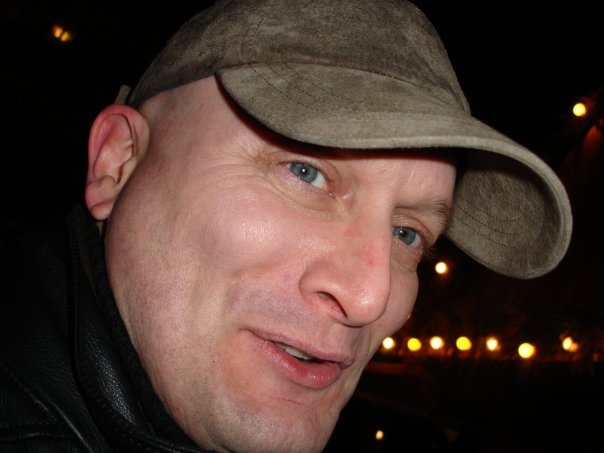 and is a completely new and somewhat darker interpretation of Dan Dare. Since October 2003, however, Dare's adventures have also continued in Spaceship Away, a specialist magazine created by Rod Barzilay by agreement with the Dan Dare Corporation. Published three times a year, its mission statement is basically to continue the original Dare's adventures where the original Eagle left off, in a style as close to that of the classic strip as possible. To that end, Barzilay originally hired former Eagle artist Keith Watson, and following Watson's death Don Harley, both of whom had drawn Dare in the sixties, to work on the strips which are written very much in the style of the fifties stories. Despite a fairly small circulation (it is available only via mail order, through its own website or in a select few comic shops), Spaceship Away continues to appear.
and is a completely new and somewhat darker interpretation of Dan Dare. Since October 2003, however, Dare's adventures have also continued in Spaceship Away, a specialist magazine created by Rod Barzilay by agreement with the Dan Dare Corporation. Published three times a year, its mission statement is basically to continue the original Dare's adventures where the original Eagle left off, in a style as close to that of the classic strip as possible. To that end, Barzilay originally hired former Eagle artist Keith Watson, and following Watson's death Don Harley, both of whom had drawn Dare in the sixties, to work on the strips which are written very much in the style of the fifties stories. Despite a fairly small circulation (it is available only via mail order, through its own website or in a select few comic shops), Spaceship Away continues to appear.
 and is a completely new and somewhat darker interpretation of Dan Dare. Since October 2003, however, Dare's adventures have also continued in Spaceship Away, a specialist magazine created by Rod Barzilay by agreement with the Dan Dare Corporation. Published three times a year, its mission statement is basically to continue the original Dare's adventures where the original Eagle left off, in a style as close to that of the classic strip as possible. To that end, Barzilay originally hired former Eagle artist Keith Watson, and following Watson's death Don Harley, both of whom had drawn Dare in the sixties, to work on the strips which are written very much in the style of the fifties stories. Despite a fairly small circulation (it is available only via mail order, through its own website or in a select few comic shops), Spaceship Away continues to appear.
and is a completely new and somewhat darker interpretation of Dan Dare. Since October 2003, however, Dare's adventures have also continued in Spaceship Away, a specialist magazine created by Rod Barzilay by agreement with the Dan Dare Corporation. Published three times a year, its mission statement is basically to continue the original Dare's adventures where the original Eagle left off, in a style as close to that of the classic strip as possible. To that end, Barzilay originally hired former Eagle artist Keith Watson, and following Watson's death Don Harley, both of whom had drawn Dare in the sixties, to work on the strips which are written very much in the style of the fifties stories. Despite a fairly small circulation (it is available only via mail order, through its own website or in a select few comic shops), Spaceship Away continues to appear.
Monday 28 May 2012
Sunday 27 May 2012
firepower, the best arm of the second world war
The destructive power of the combat arms -- infantry, armor, and artillery -- greatly increased in World War II. Infantry, armed in large numbers with the new all metal submachine gun, delivered firepower at rates five times greater than the infantryman of World War I. Infantry carried its own antitank weapons in the form of the American 3.5 inch Bazooka (named because of the sound it made when fired) rocket launcher or the German Panzerfaust. Dependable motorized transport, the Jeep, the "deuce and a half" truck, and the armored personnel carrier -- fully tracked, half-tracked, or pneumatic tire vehicles -- increased infantry mobility twenty-fold and enabled it to keep pace with the rapid armor advance.
Saturday 26 May 2012
Friday 25 May 2012
Saturday 19 May 2012
reb artillery
 it is estimated that two thirds of all Confederate field artillery was captured from the Union. The Confederate cannons built in the South often suffered from the shortage of quality metals and shoddy workmanship. Another disadvantage was the quality of ammunition. The fuses needed for detonating shells and cases were frequently inaccurate, causing premature or delayed explosions. All that, coupled with the Union gunners' initial competence and experience gained as the war progressed, led Southern forces to dread assaults on Northern positions backed up by artillery. A Southern officer observed, "The combination of Yankee artillery with Rebel infantry would make an army that could be beaten by no one."
it is estimated that two thirds of all Confederate field artillery was captured from the Union. The Confederate cannons built in the South often suffered from the shortage of quality metals and shoddy workmanship. Another disadvantage was the quality of ammunition. The fuses needed for detonating shells and cases were frequently inaccurate, causing premature or delayed explosions. All that, coupled with the Union gunners' initial competence and experience gained as the war progressed, led Southern forces to dread assaults on Northern positions backed up by artillery. A Southern officer observed, "The combination of Yankee artillery with Rebel infantry would make an army that could be beaten by no one."Confederate batteries usually consisted of four guns, in contrast to the Union's six. This was a matter of necessity, because guns were always in short supply. And, unlike the Union, batteries frequently consisted of mixed caliber weapons. Confederate batteries were generally organized into battalions (versus the Union brigades) of four batteries each, and the battalions were assigned to the direct support of infantry divisions. Each infantry corps was assigned two battalions as an Artillery Reserve, but there was no such Reserve at the army level. The chief of artillery for Robert E. Lee's Army of Northern Virginia, Brig. Gen. William N. Pendleton, had considerable difficulty massing artillery for best effect because of this organization.
had considerable difficulty massing artillery for best effect because of this organization.
 had considerable difficulty massing artillery for best effect because of this organization.
had considerable difficulty massing artillery for best effect because of this organization.Friday 18 May 2012
Tuesday 15 May 2012
Monday 14 May 2012
Monday 7 May 2012
Sunday 6 May 2012
Friday 4 May 2012
timpo ivanhoe
 Timpo - Ivanhoe Series of Mounted Knights, comprising: Brian De Bois GuilbertThe title of Sir Walter Scott's novel Ivanhoe, first published in 1819, refers to its main protagonist Wilfred of Ivanhoe, the very embodiment of bravery and chivalry. However, the novel's fragmented structure in which the narrator breaches from time to time from the story offers other possibilities than heroic identification with a single character and allows other major characters to emerge: Rowena, Ivanhoe's love interest, and, most importantly, Sir Brian de Bois-Guilbert and Rebecca. Opposing blond versus dark, the novel depicts Bois-Guilbert and Rebecca as fascinating and certainly far more complex characters than Ivanhoe and Rowena.Given the website's main interest, this text aims to offer an appreciation of Bois-Guilbert's character as performed by Ciarán Hinds. Before going into detail, I will briefly recall the novel and its reception. Scott's work had a widespread influence on nineteenth-century literature and Ivanhoe is an eminent text which inspired other writers as well as composers, among them Gioacchino Rossini and Sir Arthur Sullivan, who both composed operas based on Ivanhoe's story. In 1850, Thackeray published a satirical sequel to the novel, called Rebecca and Rowena. The devouring love of the Templar Bois-Guilbert for the Jewish Rebecca became a focus of attention in Heinrich Marschner's opera Der Templer und die Jüdin (The Templar and the Jewess, 1829) and in Otto Nicolai's recently rediscovered Il Templario (The Templar, 1840). Rebecca, abducted by the Templar, is the subject of Leo Cognet's painting Rebecca and Sir Brian de Bois-Guilbert
Timpo - Ivanhoe Series of Mounted Knights, comprising: Brian De Bois GuilbertThe title of Sir Walter Scott's novel Ivanhoe, first published in 1819, refers to its main protagonist Wilfred of Ivanhoe, the very embodiment of bravery and chivalry. However, the novel's fragmented structure in which the narrator breaches from time to time from the story offers other possibilities than heroic identification with a single character and allows other major characters to emerge: Rowena, Ivanhoe's love interest, and, most importantly, Sir Brian de Bois-Guilbert and Rebecca. Opposing blond versus dark, the novel depicts Bois-Guilbert and Rebecca as fascinating and certainly far more complex characters than Ivanhoe and Rowena.Given the website's main interest, this text aims to offer an appreciation of Bois-Guilbert's character as performed by Ciarán Hinds. Before going into detail, I will briefly recall the novel and its reception. Scott's work had a widespread influence on nineteenth-century literature and Ivanhoe is an eminent text which inspired other writers as well as composers, among them Gioacchino Rossini and Sir Arthur Sullivan, who both composed operas based on Ivanhoe's story. In 1850, Thackeray published a satirical sequel to the novel, called Rebecca and Rowena. The devouring love of the Templar Bois-Guilbert for the Jewish Rebecca became a focus of attention in Heinrich Marschner's opera Der Templer und die Jüdin (The Templar and the Jewess, 1829) and in Otto Nicolai's recently rediscovered Il Templario (The Templar, 1840). Rebecca, abducted by the Templar, is the subject of Leo Cognet's painting Rebecca and Sir Brian de Bois-GuilbertStill today that couple and the novel's central villain figure continue to exert great fascination. Christopher Vogler's and Elmer Damasco's manga Ravenskull reimagines Bois-Guilbert and Rebecca as lovers who escape after Rebecca's trial and try to find a powerful talisman. Last but not least, Bois-Guilbert's famous sentence "Look your last upon the sun" appears on t-shirts of the Swedish heavy metal band Opeth.
It is not surprising that such a popular novel mixing up adventure, spectacle and romantic love has been, since the silent era, adapted eleven times for the cinema or for television. The most famous is probably Richard Thorpe's adaptation from 1952 starring Robert Taylor as Ivanhoe, Elisabeth Taylor as Rebecca, Joan Fontaine as Rowena and George Sanders as Bois- Guilbert. A Soviet film from 1983, other British and American film and television productions and the British mini series from 1997 with Ciarán Hinds as Bois-Guilbert confirm its ongoing appeal.
However, the novel cannot be read as simplistic entertainment. Dealing with ethnicity and inter-ethnic love, it points at the role of the Jew as the eternal Other for the English in a critical manner and gives - despite the recourse to stereotypes applied to Jews such as cowardice and avarice - Isaac and Rebecca important speeches. Set against the background of a beginning Jewish emancipation, Scott's novel is an early criticism of anti-Semitism in England before George Eliot's Daniel Deronda
Tuesday 1 May 2012
the longest ride
Robert "Pony Bob" Haslam (1840-1912) - was a Pony Express rider in the American Old West. He came to the United States as a teen and was hired by Bolivar Roberts,
 helped build the stations, and was assigned the run from Friday's Station (State Line) to Bucklands Station
helped build the stations, and was assigned the run from Friday's Station (State Line) to Bucklands Station  near Fort Churchill.In 1860 a series of events at a place called Williams Station in Nevada
near Fort Churchill.In 1860 a series of events at a place called Williams Station in Nevada  sparked off a battle near Pyramid Lake between Paiute Indians
sparked off a battle near Pyramid Lake between Paiute Indians  and whites from the area in and around Virginia City. The first battle resulted in the deaths of 76 whites. Until Custer's defeat at Little Bighorn sixteen years later this was the largest casualty of whites at the hands of Native Americans. A second retaliatory battle resulted in the deaths of about 160
and whites from the area in and around Virginia City. The first battle resulted in the deaths of 76 whites. Until Custer's defeat at Little Bighorn sixteen years later this was the largest casualty of whites at the hands of Native Americans. A second retaliatory battle resulted in the deaths of about 160 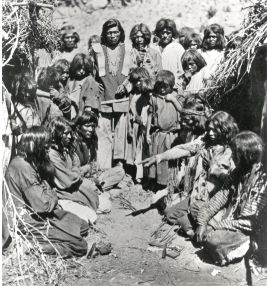 As a result of these troubles and also to protect the Pony Express, a fort was established on the Carson River along the Emigrant Trail.
As a result of these troubles and also to protect the Pony Express, a fort was established on the Carson River along the Emigrant Trail.  It was called Fort Churchill after Brigadier General Sylvester Churchill,
It was called Fort Churchill after Brigadier General Sylvester Churchill, the Inspector General of the US Army at that time. 75 miles to the east.
the Inspector General of the US Army at that time. 75 miles to the east.  Perhaps his greatest ride, 120 miles in 8 hours and 20 minutes while wounded, was an important contribution to the fastest trip ever made by the Pony Express. The message carried, Abraham Lincoln's Inaugural Address. After the Pony Express, Haslam returned as an employee of Wells, Fargo & Company, which operated its own enterprise between San Francisco and Virginia City.
Perhaps his greatest ride, 120 miles in 8 hours and 20 minutes while wounded, was an important contribution to the fastest trip ever made by the Pony Express. The message carried, Abraham Lincoln's Inaugural Address. After the Pony Express, Haslam returned as an employee of Wells, Fargo & Company, which operated its own enterprise between San Francisco and Virginia City.  He later served as a Deputy United States Marshall in Salt Lake City. In his final years he worked in the Hotel Congress in Chicago. He made a personal business card with a sketch of himself as a Pony Express rider at the age of twenty and entertained guests with stories of his adventures.
He later served as a Deputy United States Marshall in Salt Lake City. In his final years he worked in the Hotel Congress in Chicago. He made a personal business card with a sketch of himself as a Pony Express rider at the age of twenty and entertained guests with stories of his adventures.
Haslam is credited with having made the longest round trip ride of the Pony Express. He had received the eastbound mail (probably the May 10 mail from San Francisco) at Friday's Station.When he arrived at the Carson River, 60 miles away, he found that the settlers had seized all the horses at the station for use in the campaign against the Indians. He went on without a relay down the Carson River to Buckland's Station 15 miles farther At Buckland's Station his relief rider was so badly frightened over the Indian threat that he refused to take the mail. Haslam agreed to take the mail all the way to Smith's Creek for a total distance of 190 miles without a rest. After a rest of nine hours, he retraced his route with the westbound mail.  At Cold Springs he found that Indians had raided the place, killing the station keeper and running off all of the stock. Finally he reached Buckland's Station, completing a 380-mile round trip, the longest on record for the Pony Express.
At Cold Springs he found that Indians had raided the place, killing the station keeper and running off all of the stock. Finally he reached Buckland's Station, completing a 380-mile round trip, the longest on record for the Pony Express.
Haslam continued to work as a rider for Wells Fargo and Company after the U.S. Civil War, scouted for the U.S. Army well into his fifties, and later accompanied his good friend Buffalo Bill Cody on a diplomatic mission to negotiate the surrender of Chief Sitting Bull in December 1890. He drifted in and out of public mention but eventually died in Chicago during the winter of 1912 (age 72) in deep poverty after suffering a stroke. It is reported that Buffalo Bill paid for Pony Bob's headstone at Mount Greenwood Cemetery At Cold Springs he found that Indians had raided the place, killing the station keeper and running off all of the stock. Finally he reached Buckland's Station, completing a 380-mile round trip, the longest on record for the Pony Express.
At Cold Springs he found that Indians had raided the place, killing the station keeper and running off all of the stock. Finally he reached Buckland's Station, completing a 380-mile round trip, the longest on record for the Pony Express. on Chicago's far south side; however, the business records indicate it was paid for by a family member. A map to the grave site is available from the cemetery office during regular business hours (all week, 9:00 AM - 4:00 PM).When Pony Bob Haslam was buried in Chicago, 52 years had passed since thePony Express first ran. He was 1,700 miles away from his old home station. when he died, the newspapers of the day printed glowing tributes. “‘Pony Bob’ Haslam, Who Knew No Fear, Dies in Chicago -- a man once famous throughout the United States for his courage, endurance and skill.”.
on Chicago's far south side; however, the business records indicate it was paid for by a family member. A map to the grave site is available from the cemetery office during regular business hours (all week, 9:00 AM - 4:00 PM).When Pony Bob Haslam was buried in Chicago, 52 years had passed since thePony Express first ran. He was 1,700 miles away from his old home station. when he died, the newspapers of the day printed glowing tributes. “‘Pony Bob’ Haslam, Who Knew No Fear, Dies in Chicago -- a man once famous throughout the United States for his courage, endurance and skill.”.He was born in London, England in 1840 and as a teen, immigrated to the United Sates. He made his way to Salt Lake City where he worked on a ranch and as a government messenger. He was at home on a horse. He was loyal, brave, and committed to getting the job done.
As stated his greatest ride, 120 miles in 8 hours and 20 minutes while wounded, was his most important contribution and the fastest trip ever made by the Pony Express. The message carried was Abraham Lincoln's Inaugural Address.
Although the Pony Express proved that the central/northern mail route was viable, its owner, Russell, Majors and Waddell, did not get the contract to deliver mail over the route and its brief existence ended in October, 1861. Afterwards, Haslam went to work for Wells, Fargo & Company, which operated its own enterprise between San Francisco and Virginia City, Nevada. When the telegraph reached Virginia City 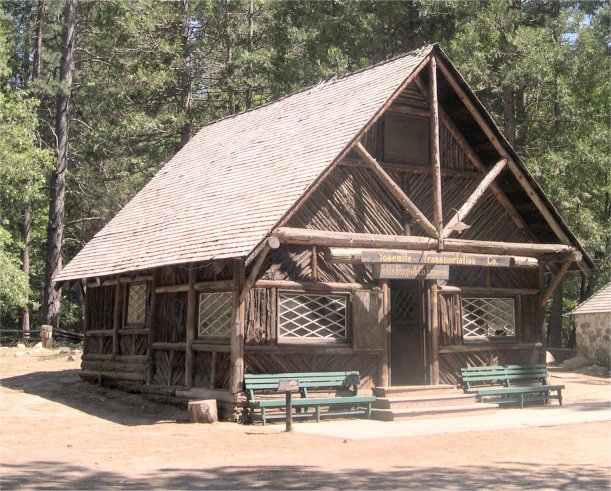

Virginia City is one of the oldest established communities in Nevada. Folklore indicates that the town got its name from a man named James Finney who was nicknamed "Old Virginy". Finney was credited with discovering the Comstock Lode. His real name was James Fennimore, and he had fled his home state of Virginia after killing a man.
Like many cities and towns in the state, Virginia City was a mining boomtown; it appeared virtually overnight as a result of the Comstock Lode silver strike of 1859.

During its peak, Virginia City had a population of over 15,000 residents and was called the richest city in America.[2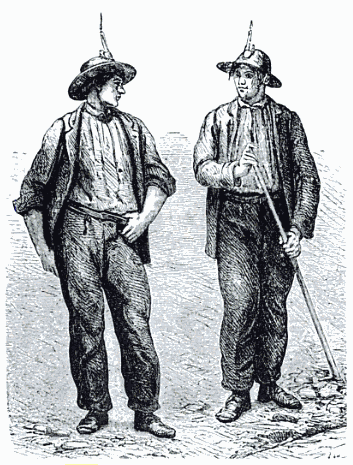

] During the 20 years following the Comstock success "about $400 million was taken out of the ground." Most of the miners who came to the city were Cornishor Irish.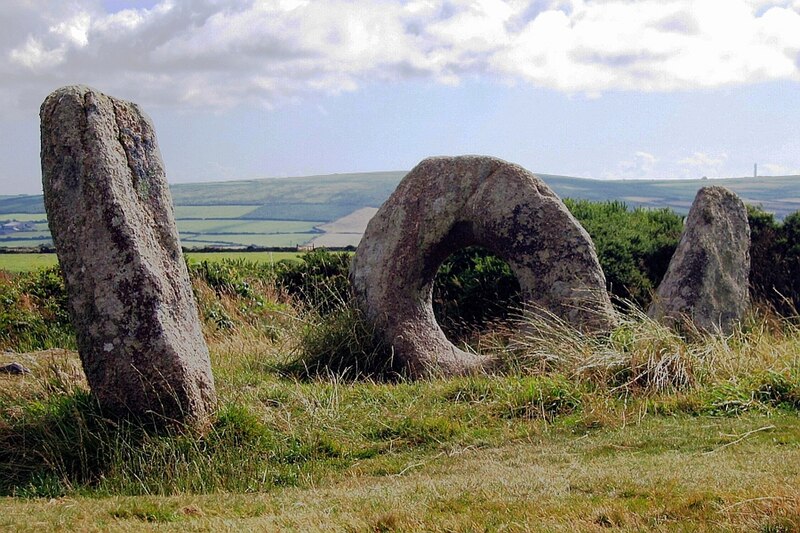

In 1870, Asians were 7.6% of the population. When the Comstock Lode ended in 1898, the city's population declined sharply.
Mining operations were hindered due to extreme temperatures in the mines caused by natural hot springs. The miners would snowshoe to work and then descend into the high temperatures. This contributed to a low life expectancy.

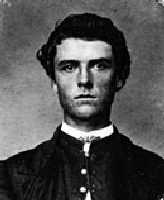
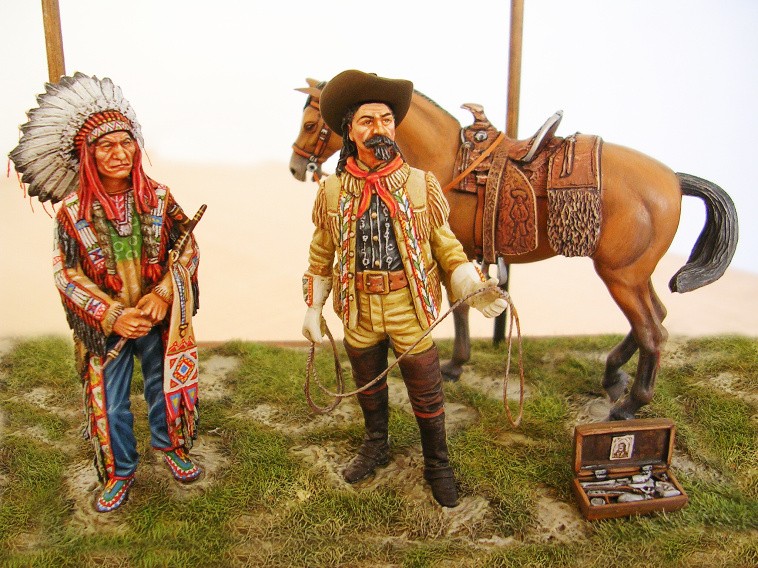
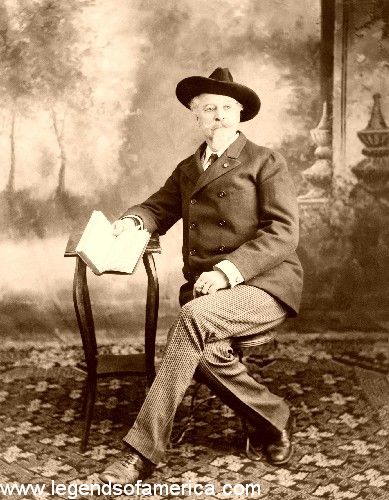
| Historical populations | |||
|---|---|---|---|
| Census | Pop. | %± | |
| 1860 | 2,345 | ||
| 1870 | 7,048 | 200.6% | |
| 1880 | 10,917 | 54.9% | |
| 1890 | 6,433 | −41.1% | |
| 1900 | 2,695 | −58.1% | |
| 1910 | 2,244 | −16.7% | |
| 1920 | 1,200 | −46.5% | |
| 1930 | 590 | −50.8% | |
| 1940 | 500 | −15.3% | |
| 1950 | 500 | 0% | |
| 1960 | 610 | 22.0% | |
| 1970 | 600 | −1.6% | |
| 1980 | 600 | 0% | |
| 1990 | 920 | 53.3% | |
| 2000 | 1,500 | 63.0% | |
| 2010 | 855 | ||
Virginia City could be considered the "birthplace" of Mark Twain, as it was here in February 1863 that writer 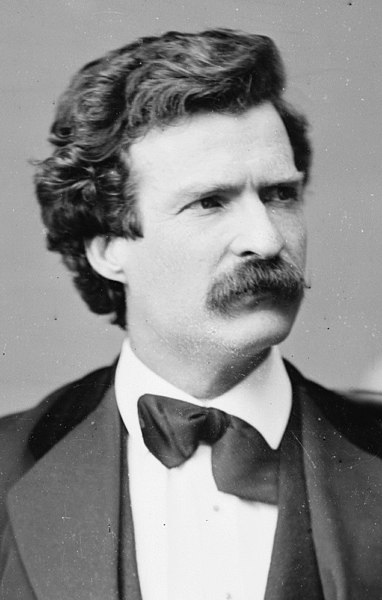
Samuel Clemens, then a reporter on the local Territorial Enterprise newspaper, first used his famous pen name. Virginia City historical documents state that Clemens was mugged on November 10, 1863, as he walked over the hill from the south while returning to Virginia City. The muggers relieved Clemens of his watch and his money. The robbery turns out to have been a practical joke played on Clemens by his friends, to give him material to write about. He did not appreciate the joke, but did retrieve his belongings - especially his gold watch (worth $300) and which had great sentimental value as well.[10] Clemens mentioned the incident in his book Roughing It, (published Feb 1872) – and was still sore about it
first used his famous pen name. Virginia City historical documents state that Clemens was mugged on November 10, 1863, as he walked over the hill from the south while returning to Virginia City. The muggers relieved Clemens of his watch and his money. The robbery turns out to have been a practical joke played on Clemens by his friends, to give him material to write about. He did not appreciate the joke, but did retrieve his belongings - especially his gold watch (worth $300) and which had great sentimental value as well.[10] Clemens mentioned the incident in his book Roughing It, (published Feb 1872) – and was still sore about it

Samuel Clemens, then a reporter on the local Territorial Enterprise newspaper,
 first used his famous pen name. Virginia City historical documents state that Clemens was mugged on November 10, 1863, as he walked over the hill from the south while returning to Virginia City. The muggers relieved Clemens of his watch and his money. The robbery turns out to have been a practical joke played on Clemens by his friends, to give him material to write about. He did not appreciate the joke, but did retrieve his belongings - especially his gold watch (worth $300) and which had great sentimental value as well.[10] Clemens mentioned the incident in his book Roughing It, (published Feb 1872) – and was still sore about it
first used his famous pen name. Virginia City historical documents state that Clemens was mugged on November 10, 1863, as he walked over the hill from the south while returning to Virginia City. The muggers relieved Clemens of his watch and his money. The robbery turns out to have been a practical joke played on Clemens by his friends, to give him material to write about. He did not appreciate the joke, but did retrieve his belongings - especially his gold watch (worth $300) and which had great sentimental value as well.[10] Clemens mentioned the incident in his book Roughing It, (published Feb 1872) – and was still sore about it
The Virginia & Truckee Railroad's northern terminus is located at Virginia City. A project was started in 1977 to begin rebuilding one of the nations "crookedest railroads." The portion of line that has been rebuilt so far stretches south to Carson City, Nevada, and through Gold Hill. The project ran the first steam engine from Carson City on September 5, 2009. Meanwhile, other trains are pulled by historic locomotives between Virginia City and Gold Hill, attracting thousands of tourists each year.The population of Virginia City is about 1,000 people in the town. 4,000 live in Storey County. It has one elementary school (Hugh Gallagher Elementary School), one middle school (Virginia City Middle School) and one high school (Virginia City High School). Many locals work at the shops in town that cater to tourists, while others seek jobs in the surrounding cities.There is an annual hillclimb that runs from Silver City to Virginia City via Highway 341 (a truck route) that is put on jointly between the Ferrari Club of America Pacific Region and the Northern California Shelby Club. Originally the event was put on by the SCCA and took the same route. Highway 342 is now the return route for cars that have completed their runs up Highway 341. The hillclimb covers 5.2 miles (8.4 km), climbing 1,260 feet (380 m) and passing through 21 corners.Virginia City is home to several buildings and artifacts that remain from the time it was a boom town. Among them are the Bucket of Blood saloon, the old globe, the Silver Queen, and the suicide table. Occasionally a gunfight is acted out.

The Red Dog Saloon, originally the 1875 Comstock House, is located at 76 North C Street. The Red Dog Saloon gave many San Francisco rock musicians their start during the summer of 1965.
Subscribe to:
Posts (Atom)




